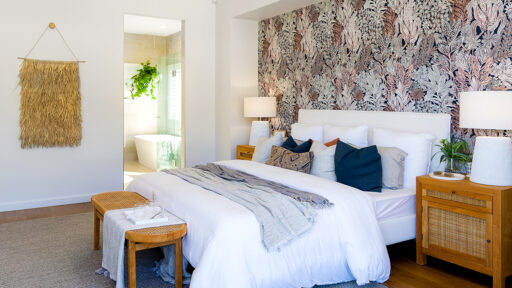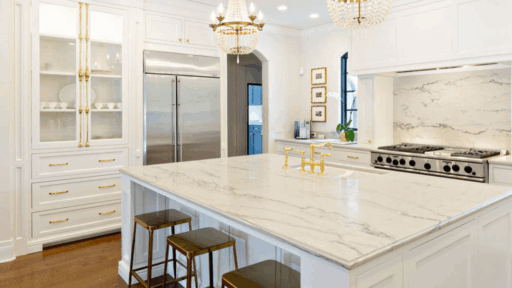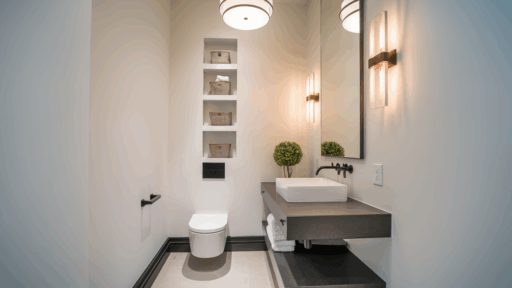Creating a calming bedroom can make a big difference for a child with autism. I’ve learned that a peaceful space helps kids feel safe, sleep better, and handle stress.
Every child is different, so the right setup depends on their needs.
Some need quiet corners. Others respond well to soft lights or gentle textures.
The goal is to create a room that feels just right for them. You don’t have to spend a lot or make big changes.
Even small ideas, like adding a swing or using blackout curtains, can help. In this post, I’ll share sensory bedroom ideas that are simple, helpful, and easy to try.
These ideas can make bedtime smoother and the whole room more comfortable. If you’re looking to create a safe and soothing space, you’re in the right place.
Why Sensory Bedrooms Help Children with Autism?
Many children with autism see, hear, and feel the world differently than we do. Their brains process sensory input in ways that can be too much (overload) or too little (under-stimulation).
Imagine trying to sleep while feeling like your skin is buzzing, the sheets are sandpaper, or normal shadows look scary. This is what a regular bedroom might feel like to your child.
A sensory-friendly bedroom gives your child what they need most: a space that makes sense to them.
When your child can control their environment, dimming bright lights, wrapping in a heavy blanket, or listening to soft sounds, they gain comfort and safety.
The right room setup helps your child:
- Fall asleep faster
- Stay asleep longer
- Feel calmer at bedtime
- Have fewer meltdowns
- Gain independence
The right pillow, a sound machine, or blackout curtains can truly change daily life for your whole family.
You know your child best. Small tweaks based on what they need can make a world of difference.
Top Sensory Bedroom Ideas for Kids
Each option addresses specific sensory needs while being adaptable to your child’s preferences and your budget.
1. Weighted Blanket
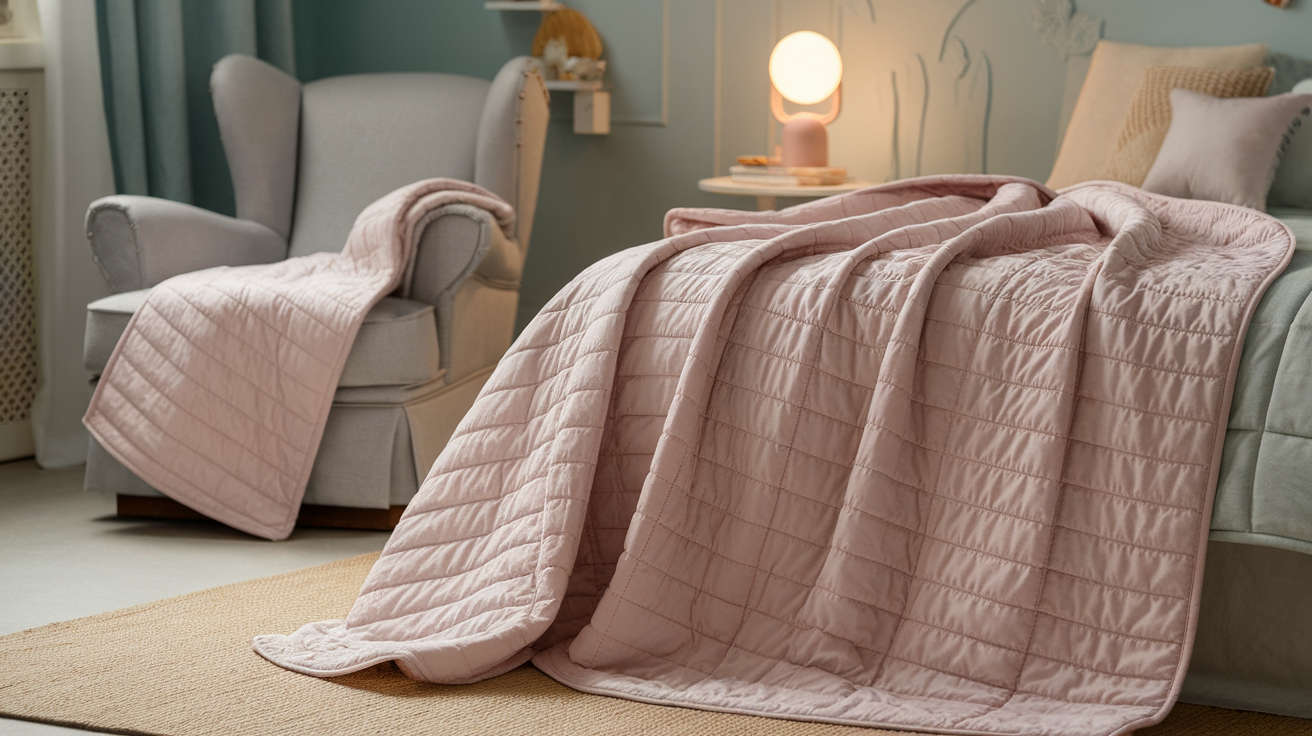
This special blanket has tiny glass beads or plastic pellets sewn inside to add weight. The gentle pressure on your child’s body can help them feel secure and calm.
Many kids who struggle to settle down find that the steady weight helps their bodies relax and prepare for sleep.
Unique features:
- Washable covers that can be removed
- Various fabric options to match sensory preferences
- Can be used on the bed or during quiet time in other areas
2. Dimmable Lighting
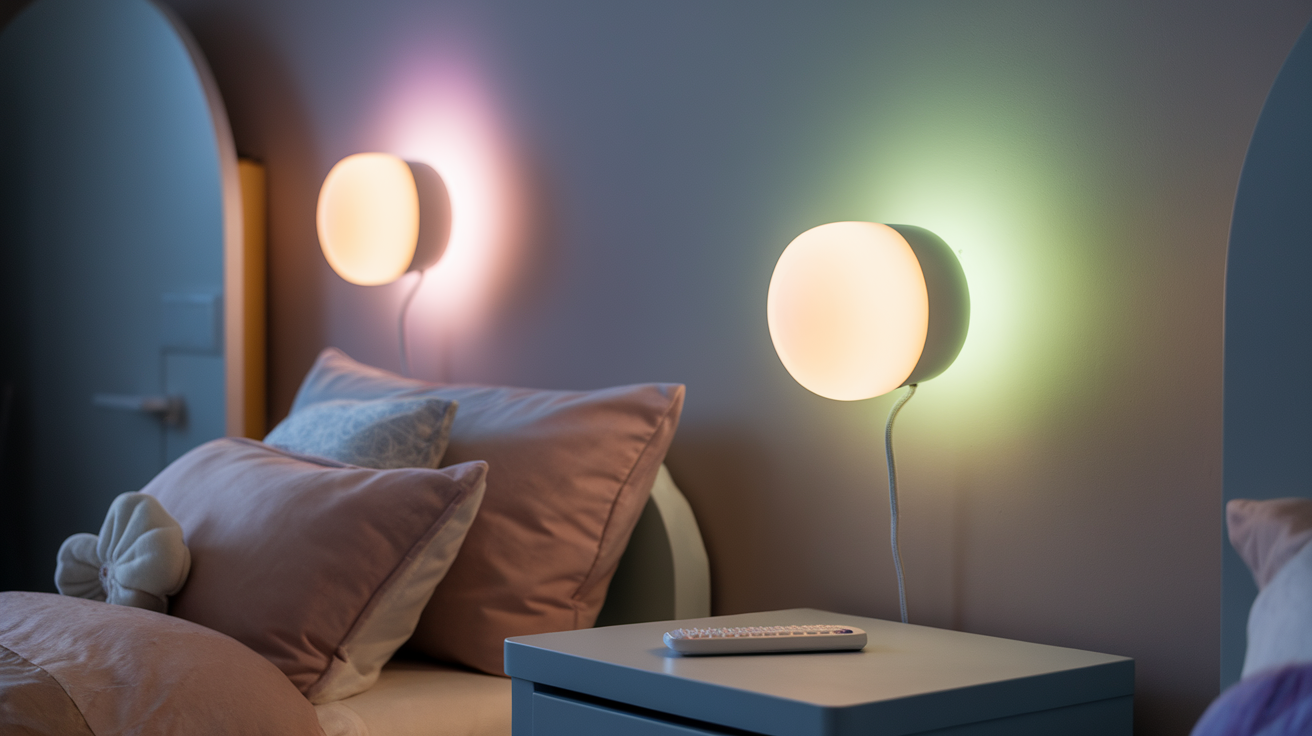
Regular lights can be too bright or harsh for sensitive eyes. Lights you can adjust, let your child control how bright or dim their room is.
This gives them power over their space and can reduce headaches, eye strain, and stress at bedtime.
Unique features:
- Color-changing bulbs for different moods
- Timer settings for gradual wake-up or bedtime
- Can be installed in existing fixtures
3. Textured Wall Panels

These panels add different textures to the touch and feel of the walls.
They give your child a safe way to meet their need for tactile input. When they feel overwhelmed, running their hands across various surfaces can be calming and grounding.
Unique features:
- Can cover a small section or an entire wall
- Often removable for cleaning or rearranging
- May include interactive elements like buttons or sliders
4. Noise-Reducing Curtains
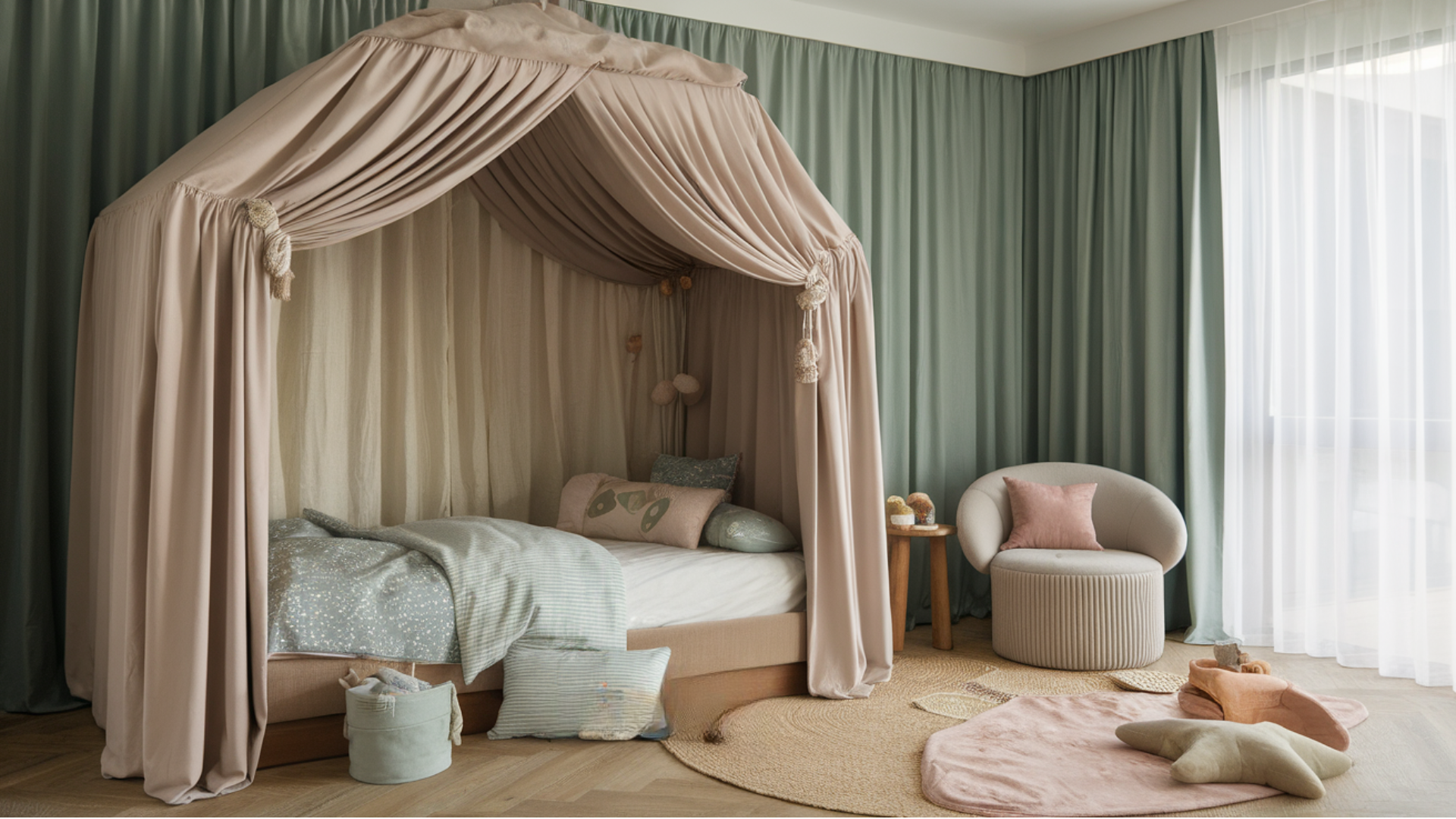
These thick curtains help block sounds from outside the room. They create a quieter space for children who get upset by sudden or loud noises.
The heavy fabric also blocks light, making the room darker for better sleep.
Unique features:
- Multiple layers of dense fabric
- Can reduce noise by 15-30 decibels
- Available in child-friendly patterns and colors
5. Canopy or Bed Tent
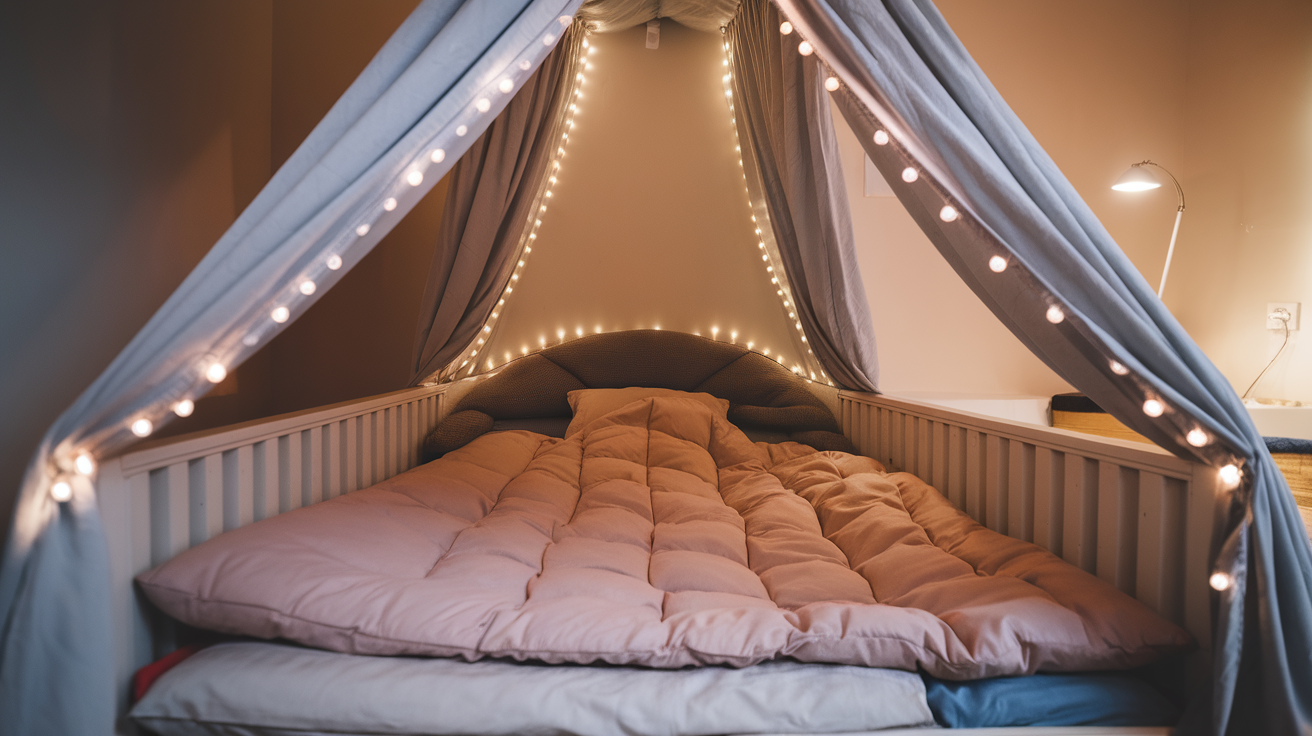
This creates a smaller, more defined space within the bedroom. For kids who feel lost or exposed in an open room, having boundaries helps them feel secure.
The semi-enclosed space can reduce visual input and create a cozy retreat.
Unique features:
- Easy to set up or take down
- Can be paired with twinkle lights for a gentle glow
- Creates a clear boundary between sleep space and play space
6. Low-Stimulation Color Scheme
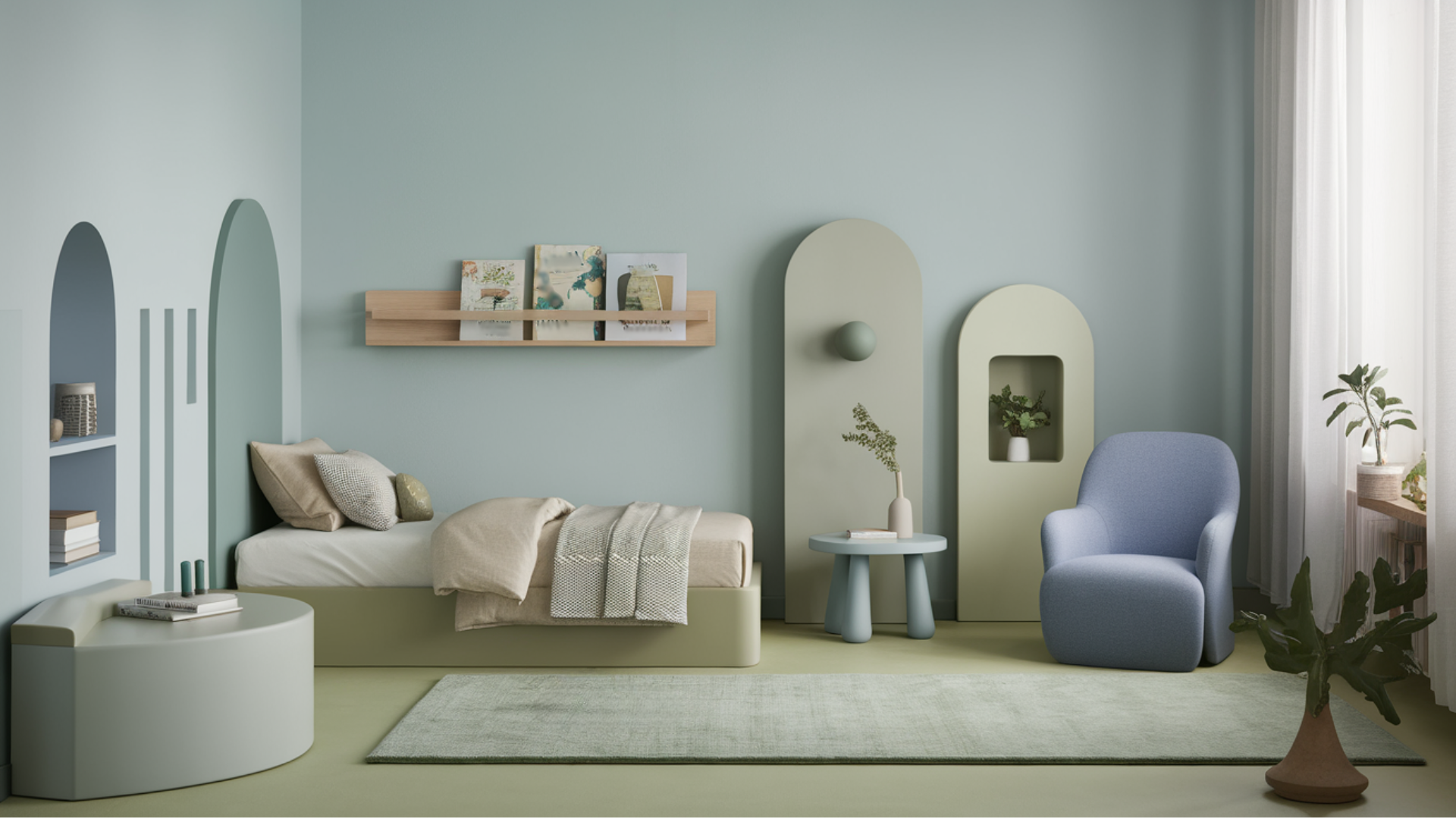
Soft, muted colors on walls and furniture help create a calm feeling in the room.
Bright colors and busy patterns can make some children feel weird or anxious. Gentle blues, greens, or neutral tones support relaxation and focus.
Unique features:
- Matte paint finishes to reduce glare
- Coordinated bedding and furnishings for visual harmony
- Easy to change with removable wall decals as preferences change
7. Sensory Swing or Hanging Chair

The gentle rocking motion helps children regulate their nervous systems. This kind of movement can be deeply calming and organizing for the brain.
Having a safe place to swing, spin, or rock gives your child a healthy way to meet their movement needs.
Unique features:
- Can be installed in ceiling joists or with special stands
- Various styles, including cocoon, platform, or hammock types
- Often foldable when not in use to save space
8. Fidget Corner or Sensory Nook

This special area holds items your child can use to keep their hands busy and their mind calm.
Having a dedicated space for sensory tools teaches your child when and where to seek input. This helps them learn to manage their own needs.
Unique features:
- Containers to organize different sensory tools
- May include a small table or tray for activities
- Can be separated by a bookshelf or room divider
9. Soft Foam Flooring or Mats
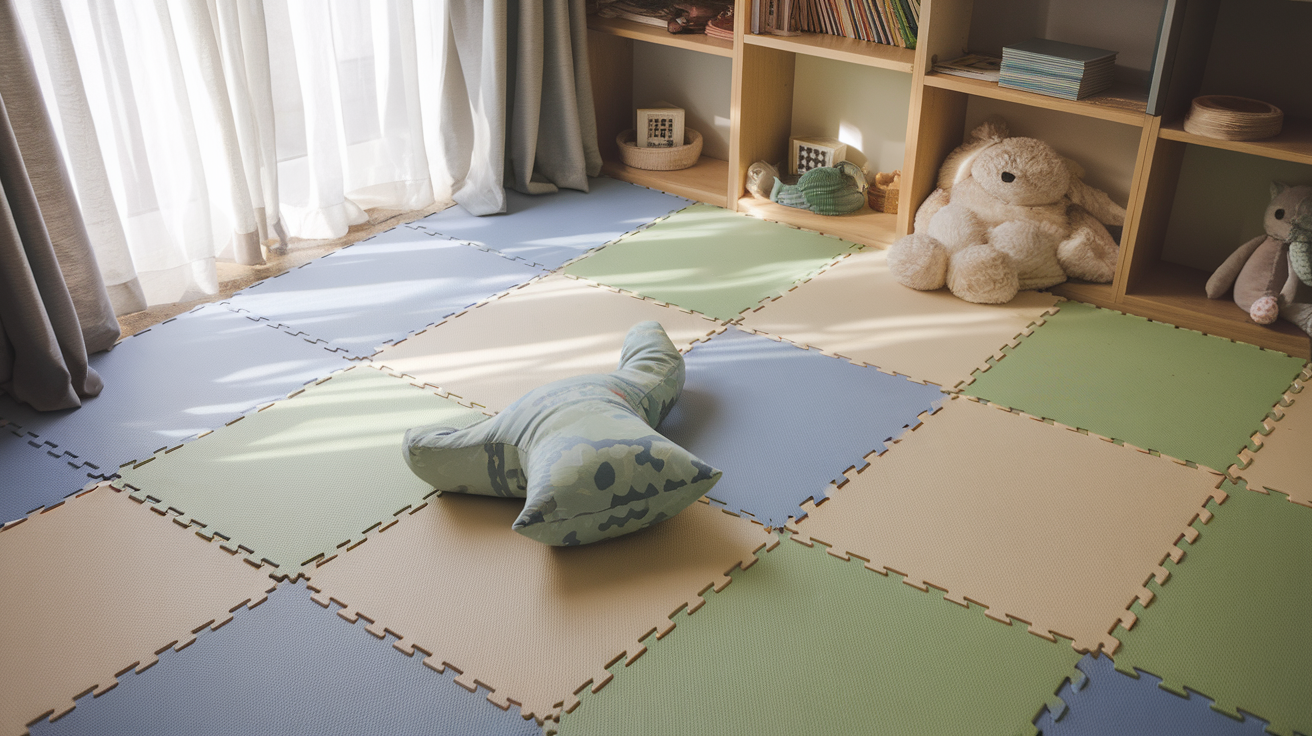
These cushioned mats make the floor softer for play, rolling, or resting.
They protect against bumps and create a comfortable surface for floor-based activities. The gentle give under pressure feels good to many children who seek deep pressure.
Unique features:
- Non-slip bottoms for safety
- Easy to clean with mild soap and water
- Can be used in sections rather than covering the entire floor
10. Bubble Tube or Lava Lamp

These visual tools provide gentle movement and light that can be calming to watch.
The slow-rising bubbles or blobs create a predictable pattern that helps some children focus and settle their thoughts. They also serve as soft night lights.
Unique features:
- Often includes a remote control
- Some have settings for different bubble speeds
- Can be placed on sturdy shelves or tabletops
11. White Noise Machine
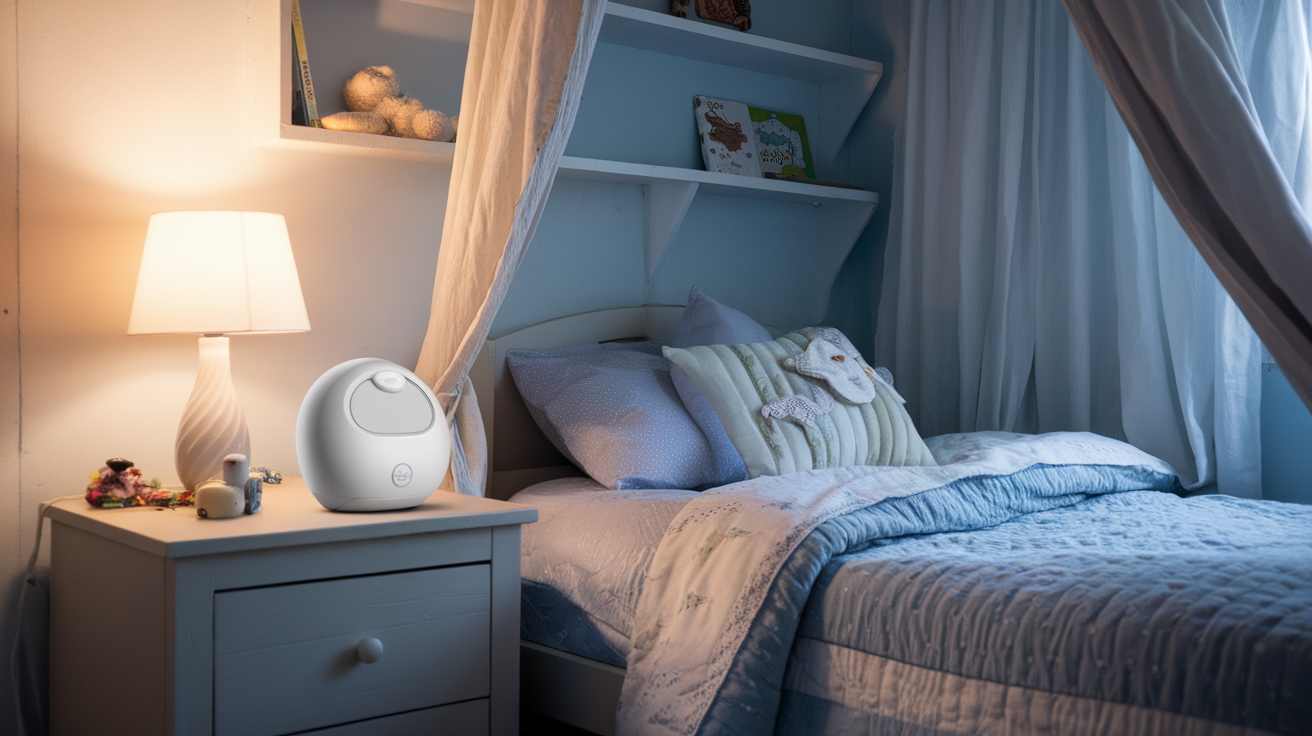
This device creates steady background sounds that mask disturbing noises. The consistent audio helps block out sudden sounds that might wake or upset your child.
Many children sleep better with gentle white noise in the background.
Unique features:
- Multiple sound options (fan, rain, ocean waves)
- Timer functions for automatic shut-off
- Portable for travel
12. Glow-in-the-Dark Ceiling Stars
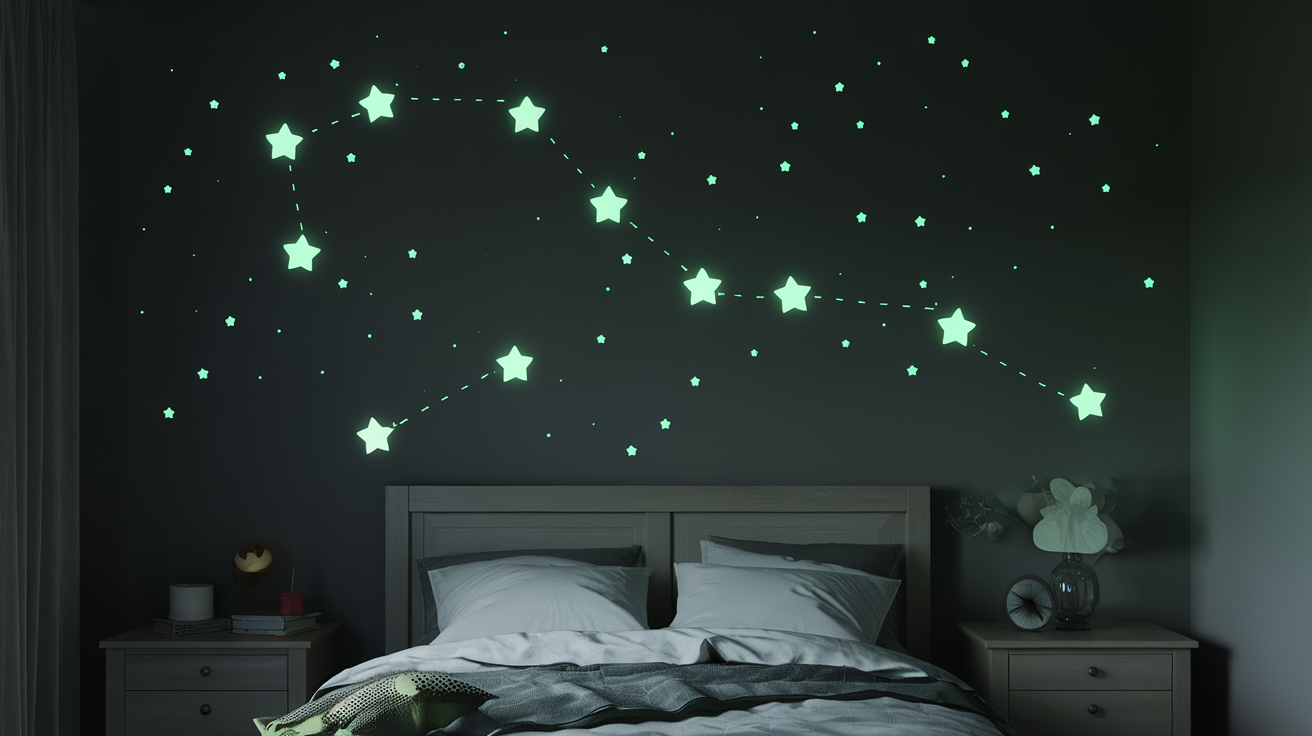
These stick-on stars create a gentle glow that slowly fades as your child falls asleep.
The soft light helps ease fears of the dark without being too bright. Watching the stars can become part of a calming bedtime routine.
Unique features:
- Recharge in daylight or with a flashlight
- No batteries or electricity needed
- Available in different sizes and brightness levels
13. Body Pillow or Hugging Cushion
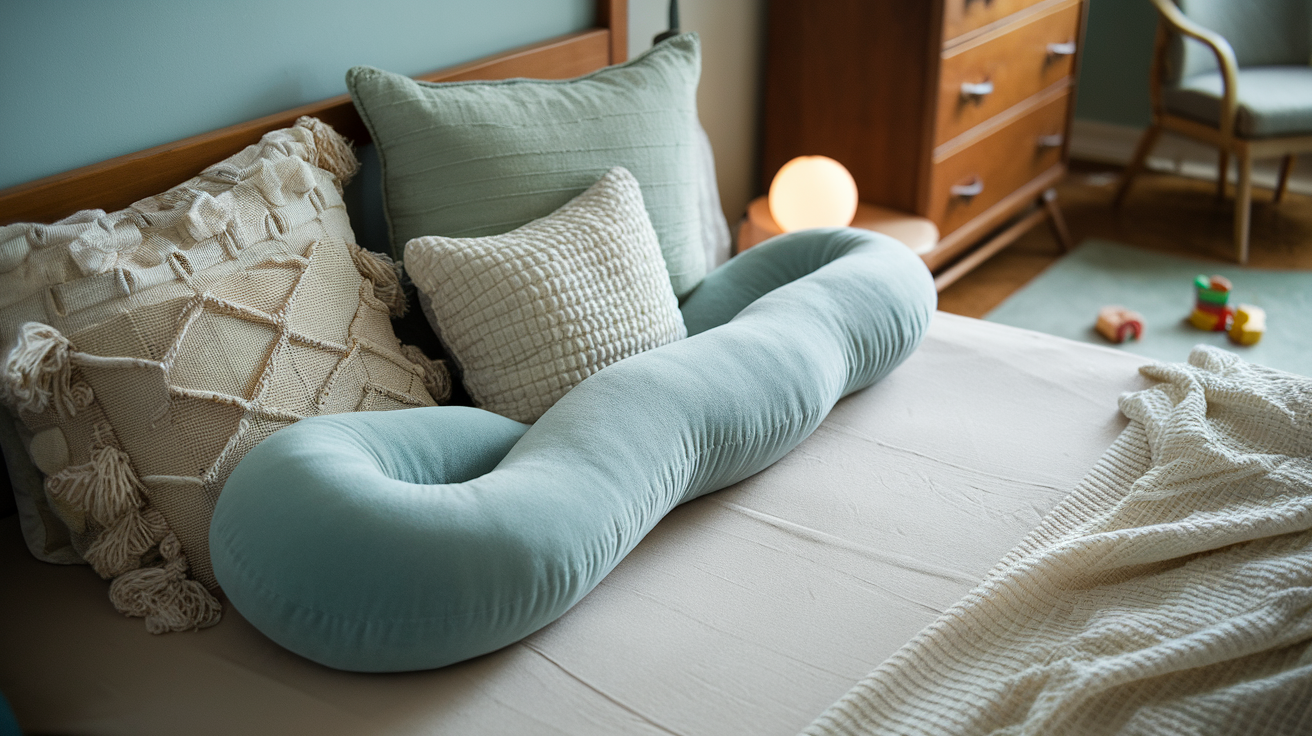
These long pillows provide comfort through gentle pressure and support. Children who seek deep pressure often find hugging these pillows very soothing.
They can wrap their arms and legs around it for a sense of security.
Unique features:
- Washable covers in different textures
- Can be used alongside the body or as a nest
- Different shapes available (U-shape, straight, or character designs)
14. Aromatherapy Diffuser with Calming Scents
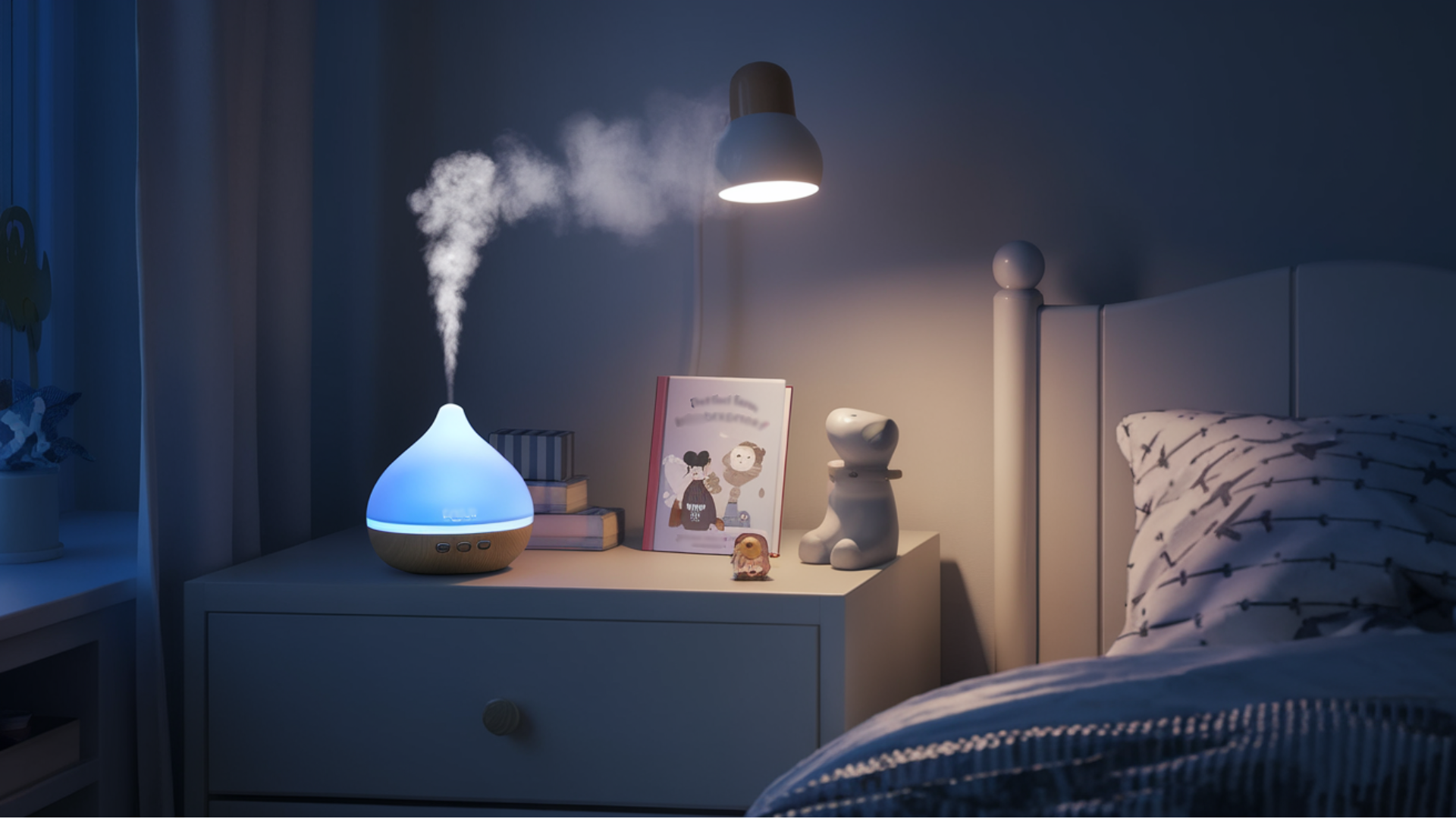
This device releases tiny particles of essential oils into the air.
Scents like lavender or chamomile can help signal the brain that it’s time to relax. The subtle fragrance creates a sensory cue for bedtime routines.
Unique features:
- Adjustable mist settings
- Auto shut-off for safety
- Timer functions for controlled use
15. Tactile Bedding (like Minky or Flannel)
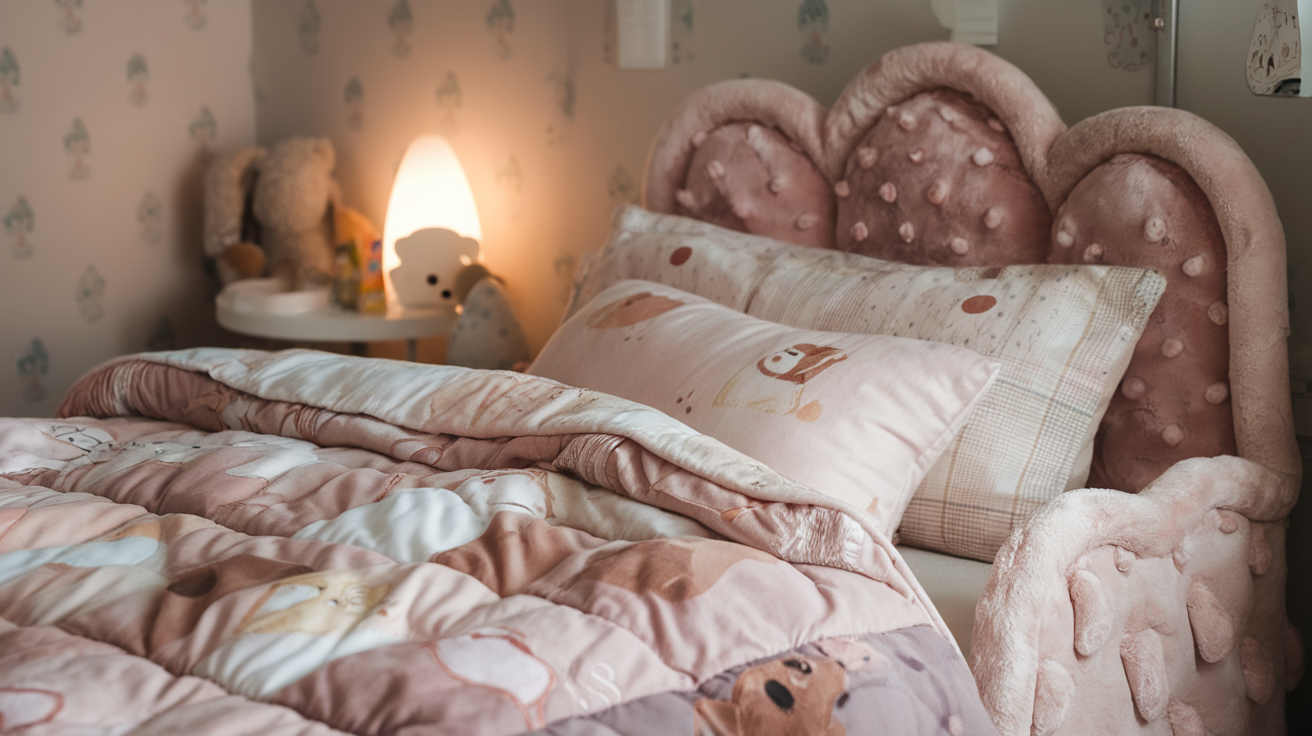
Special fabrics with interesting textures give your child sensory input while they sleep. The right texture can be comforting rather than irritating.
Finding the perfect fabric for your child might take some testing, but it makes a big difference.
Unique features:
- Various options from very smooth to subtly textured
- Often, hypoallergenic options are available
- Can mix and match pillowcases and sheets for different needs
Parent Tips for Maintaining a Sensory Bedroom
These practical tips come from parents who’ve been where you are now. They’ve found ways to make sensory spaces sustainable, adaptable, and truly helpful for their children with autism.
1. Start with What You Have
I often tell parents to begin with small changes. You don’t need to redo the entire room at once. Add one sensory item this week, maybe a new pillow or light filter.
See how your child responds before adding more. Perfect bedrooms don’t exist; helpful ones do.
2. Let Your Child Lead
When possible, include your child in decisions. Show them two fabric samples and watch which one they touch longer.
Offer color choices for their weighted blanket. Let them name their quiet corner. This builds ownership and helps them feel in control of their space.
3. Keep It Fresh
Too many items can cause stress instead of calm. I suggest creating a rotation system for sensory toys and tools.
Store extras in bins and swap them every few weeks. This prevents clutter while giving your child the excitement of rediscovering favorites.
4. Watch And Learn
Your child will show you what works. Do they always head for the bean bag? Do they avoid the textured wall?
Pay attention to these cues. Make notes on your phone about which items help during tough days. Adjust the room based on what you notice.
5. Build Bedroom Routines
Connect daily activities to the sensory elements in the room. Maybe the bubble tube means story time.
Perhaps the weighted blanket signals that bedtime is near. These patterns help your child understand what comes next and feel safe in their space.
Conclusion
Creating a sensory bedroom isn’t about a strict plan; it’s about knowing what helps your child feel calm and safe. You know your child best.
I’ve seen families make bedtime easier with just a few simple changes. Maybe it’s a weighted blanket, soft lighting, or a cozy nook.
Every small step you take matters. A more comfortable space can help your child relax, which in turn makes life better for everyone.
Try what feels right. Skip what doesn’t. You can constantly adjust things as your child grows and changes.
You’re not alone in this. Many parents face similar challenges and discover what works for them.
Your effort to create a safe and soothing space shows how much you care. That love and care make all the difference.





